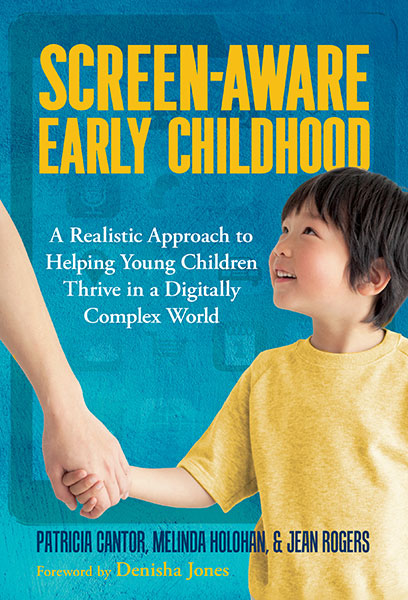Professors: Request an Exam Copy
Print copies available for US orders only. For orders outside the US, see our international distributors.
Patricia Cantor, Melinda Holohan, Jean Rogers
Foreword by: Denisha Jones
Publication Date: October 24, 2025
Pages: 192

Use screen awareness to nurture and safeguard child development from birth to age 8 in the digital age.
This book equips early childhood professionals to grow their “screen awareness”—the knowledge and practices that uphold the developmental well-being and rights of children in a screen-based, media-centric society.
The authors introduce the Screen-Aware Framework for Early Childhood (SAFEC), a versatile approach for making informed, intentional decisions about screen use, time, and content across diverse home, classroom, and child care settings. The book highlights consequential research findings and myths about young children and screens; builds awareness of the influence of screen-based media, including problematic industry practices; and digs into protective factors for reducing risks and identifying priorities for strengthening child and family resilience.
Full of practical information, strategies, tools, and resources for developing screen-aware practices, policies, and partnerships, Screen-Aware Early Childhood is essential guidance for all those who educate and care for young children.
Book Features:
Patricia Cantor is professor emerita of early childhood studies and former associate provost at Plymouth State University, New Hampshire. Melinda Holohan serves as faculty specialist in family science and human development at Western Michigan University. Jean Rogers is director of the Screen Time Action Network at Fairplay, a global collaborative of practitioners, educators, advocates, and parents.
“As a professor of early childhood education, I appreciate how this book connects screens with the bioecological model of development and provides readers with a thorough understanding of how screens impact multiple facets of our lives…. We must keep our kids safe, and this book is a fantastic tool to do just that.”
—From the Foreword by Denisha Jones, executive director, Defending the Early Years
“Here is the book that parents and early childhood practitioners have needed! It's a comprehensive manual examining the complexities of growing up in a digitally driven, screen-centered world that offers the hopeful possibility of navigating that world with informed awareness and a continuing commitment to preserving young children's well-being and healthy development.”
—Nancy Carlsson-Paige, professor emerita, Lesley University
"This book is a smart, compassionate guide for raising curious, confident kids in today’s connected world."
—Kris Perry, executive director, Children and Screens: Institute of Digital Media and Child Development
"In Screen-Aware Early Childhood, Cantor, Holohan, and Rogers have gifted us a strengths-based, research-informed guide for navigating the complexities of young children’s screen experiences. As both a researcher and a parent, I appreciate how their Screen-Aware Framework (SAFEC) acknowledges the challenges of raising children in a digitally saturated world while offering practical, developmentally-grounded strategies that resonate deeply with everyday realities."
—Katie Davis, associate professor, University of Washington
“Screen-Aware Early Childhood is a life vest for parents and teachers drowning in masses of digital products claiming to help children learn. Thanks to the authors for hammering in the important message that screens are only a supplement to learning, not a substitute for learning. Human-to-human interaction in conversation or around screens remains the magic sauce to raising and teaching healthy, happy children.”
—Kathy Hirsh-Pasek, coauthor of Einstein Never Used Flashcards, professor of psychology and neuroscience at Temple University, and Senior Fellow at Brookings
Foreword Denisha Jones xi
Acknowledgments xiii
Introduction 1
Part I: Cultivating Screen Awareness
1. Navigating the Screenscape 7
Growing Up in a Screen-Saturated World 7
Why Screen Aware? 11
The Screen-Aware Framework for Early Childhood (SAFEC) 13
Questions for Reflection 23
2. Focusing on Development 24
Core Developmental Needs 24
Questions for Reflection 42
3. Looking to Research 43
Common Screen Myths 43
Critical Findings 48
The Benefits of Research-Informed Practice 57
Questions for Reflection 58
4. Promoting Protective Factors 60
A Strengths-Based Lens 60
Family Protective Factors and Screen Awareness 61
Screen-Aware Protective Factors 69
Questions for Reflection 81
Part II: Advancing Screen Awareness
5. Fortifying Caregiver–Child Relationships 85
Barriers to Connection 85
Strengthening Connections 90
Summary of Key Points 96
Applying Screen Awareness 97
6. Safeguarding Children From Exploitation 98
Children as Targets 98
Child Rights and Risks in the Digital Age 103
Summary of Key Points 114
Applying Screen Awareness 115
7. Activating Screen Awareness 116
Effective Communication Strategies 116
Professional Learning and Development 120
Action Planning for Screen-Aware Practices 125
Summary of Key Points 130
Applying Screen Awareness 130
8. Establishing Policies and Partnerships 132
Program/School-Level Policies 132
Local/State Level 138
National Level 142
Summary of Key Points 144
Applying Screen Awareness 145
Epilogue: Advocating for Screen Awareness 146
Appendix A: Action Planning With SMART Goals 151
Appendix B: Sample Phone-Free Zone Sign 153
References 155
Index 173
About the Authors 177
Professors: Request an Exam Copy
Print copies available for US orders only. For orders outside the US, see our international distributors.